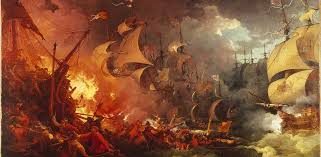
The disastrous attempt by King Philip II of Spain to invade England during the reign of Queen Elizabeth I as part of his plan to restore England to the Catholic fold and to establish a pan-European Catholic kingdom.

Already in the reign of Queen Mary Span was looking towards the glory of being the instrument of restoring England to the Catholic fold. Towards this end Philip II of Spain had married Mary even though she was nearly a decade older than him. A male heir born to them would assure the future of England as a Catholic nation. Despite a number of phantom pregnancies, however, Mary died without a child. Within hours of hearing of her death, Philip had sent an envoy to check out the prospects of marrying her sister, Elizabeth, her successor to the throne of England.
When Pope Sixtus V ascended to the throne of St Peter in Rome in April 1585, he challenged Philip to prove himself a faithful Catholic. One of the challenges was to overthrow Elizabeth and replace her with James VI of Scotland (whom Philip had, of course, first to convert to the Catholicism). The Spanish Armada was part of Philip's plan to meet the pope's challenge.
Philip's plan for the invasion of England was focused on a land campaign. He ordered his general, the Duke of Parma (then engaged in the Netherlands) to assemble a task force of 26,000 crack troops ready to be shipped across the English Channel on flat-bottomed barges for the invasion. A second prong of the strategy was a fleet of ships—the Armada itself—carrying 18,500 troops (most raw recruits) to cover the invasion of by the crack troops. This meant that Armada had first to sail to the Netherlands before they would begin their real work.
The first ships of the Spanish Armada was sighted off the Lizard (the most south-westerly point of the British mainland in Cornwall) on the afternoon of 19 July, a Friday. The English naval forces—led by the Lord Admiral, Lord Howard and Sir Francis Drake—began tailing them. By Sunday afternoon the English fleet had come within firing range of Spaniards. With their smaller but faster ships, the English were able to outsail and outgun their enemies. Soon the Nuestra Senora del Rosario, one of the largest of the Spanish front-line ships was demasted and lost. There was another engagement on Tuesday when the Santa Ana, flagship of the Armada's second-in-command was damaged and abandoned. By Saturday afternoon the Armada had made it to Calais, where they anchored to wait for Parma's barges. But they never showed up; Parma's troops were not ready and, worse, they discovered that the flat-bottom barges they intended to use for the crossing was unsuitable for the open seas. Furthermore, their excess to the open sea was blocked by the Dutch, with whom they were already at war.
As the Spaniards waited, the English rigged up a number of fire-ships (ships filled with combustibles) and sailed them into the anchored Armada, the small number of crews manning them jumping overboard as soon as they had lit the fuses. What was not destroyed tried to escape sailing north towards the North Sea—hoping to make it home by sailing around the north of the British Isles and then south around Ireland—with the English ships in pursuit, . A "Protestant wind," however, scattering what was left of the Armada, and Spaniard bodies were found all along the coasts.
Though Philip had no way to predict the storm he was, nonetheless, largely to be blamed for the failure of the Armada; his plan was over-complicated and he micro-managed. The disaster, however, did not deter him from his aim of being "the hammer of the heretics" or his goal of establishing a Spanish-Habsburg world order. He continued to war against the Calvinistic Dutch and France—then in the throbs of a long and ghastly religious war between the Catholics and the Huguenots—with England reluctantly abetting them both for the next two decades, during which there were three more attempts of another Armada against England. By late 1590s the wars were driving Spain towards bankruptcy and Philip realized that if he continued with the hostilities he would very soon have nothing left to leave to his son as an inheritance. He made peace with France and the Dutch in 1598. Elizabeth refused a formal peace though she yearned for it; her honour would not allow her to do so. A few months later Philip died, and was succeeded by his 23-year-old son, Philip III. Philip Jr was no warmer in his feelings towards Elizabeth than his father was.

BIBLIOGRAPHY:
Colin Martin and Geoffrey Parker, The Spanish Armada. Rev. ed., Manchester: Manchester University Press, 1999.

©ALBERITH
070919lch